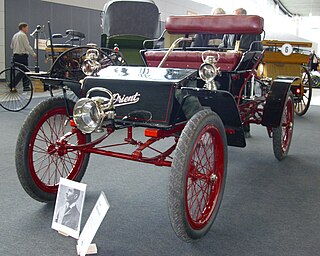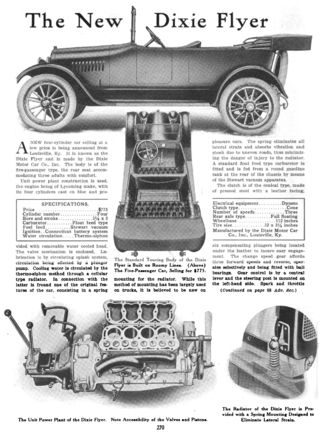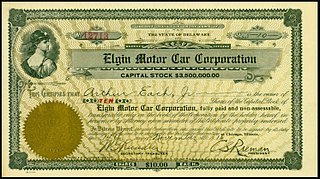The Waltham Steam was an American steam car.

The Waltham Steam was an American steam car.

Engineers George M. Tinker and John W. Piper were employees of the Waltham Manufacturing Company, [1] at that time makers of Orient brand bicycles in Waltham, Massachusetts. In 1898, they were allowed by the company's owner, Charles Herman Metz, to build a light steam buggy at a corner of the plant. This vehicle was finished at the end of the year and named the Waltham Steam. It had a very light 50 lb (23 kg), 3 hp (2.2 kW) two cylinder, double acting steam engine. The copper-built condenser weighted in at 110 lb (50 kg), and the complete vehicle at only 600 lb (270 kg). It had wire wheels, and steering was provided by a vertically mounted lever. Tinker and Piper exhibited their steam buggy at the Boston Automobile Show in 1898. [2]
Two more steam cars followed under the label Tinker & Piper. Meantime, Metz had sold out his company to Charles A. Coffin and H.P. Clough but stayed in the position of a general manager. Coffin was an executive of the General Electric Company (GE). Seeking markets for GE products, he ordered a light electric car to be made by Tinker and Piper. They built it also at the Waltham Manufacturing plant. It had a wheelbase of 60 in (150 cm) and an electric motor by General Electric. It was presented as the Orient Electric at the New York Cycle & Automobile Show in 1899. Neither Tinker and Piper nor Metz were impressed, and there were no more electric vehicles to follow. [2]
In 1899 [3] or early 1900, [2] [4] Tinker and Piper left the Waltham Manufacturing Company through consensual agreement with, and support from, Charles Metz, to start their own business. [2] Their Waltham Automobile Company was located at 130-136 Newton Street in Waltham [4] and started building small steam-powered stanhopes that sold for $750 [1] [2] [4] with a Victoria top. [4] Further, there might have been some steamers with Vis-à-vis coachwork. [4]
Production ended in 1902 [1] [2] or 1903. [4]
Of the unknown number of Waltham steam vehicles built, one Stanhope is still in existence. [4]
An unrelated company in Springfield, Massachusetts also produced a steam powered automobile under the Waltham name in 1905. [1]
The ABC was a light car which planned, in 1922, to sell for $300, but which never went into production.

Waltham Manufacturing Company (WMC) was a manufacturer of bicycles, motorcycles, motorized tricycles and quadricycles, buckboards, and automobiles in Waltham, Massachusetts. It sold products under the brand names Orient, Waltham, and Waltham-Orient. The company was founded in 1893, moving to self-propelled vehicles after 1898.

A high wheeler is a car which uses large diameter wheels that are similar to those used by horse-drawn vehicles. These cars were produced until about 1915, predominantly in the United States.
The Binghamton Electric was an American automobile manufactured only in 1920. An electric car from Binghamton, New York, the car was made probably as a prototype, by the Binghamton Electric Truck Co., located at 250, Main street. Not more than two or three two-passenger coupes were produced. The company built a small number of electric trucks in 1920–1921.

The Fal-Car, originally known as A Car Without A Name, was an American automobile manufactured from 1909 until 1914 by a company that identified itself in advertisements only as Department C, 19 North May Street, Chicago. The address had previously been the location where the Reliable-Dayton automobile had been built. It was advertised as "trim, classy, speedy and efficient".

The Gadabout was an American automobile from 1914 until 1916. A four-cylinder self-declared cyclecar, it had a body woven from so-called "waterproof reeds" (wicker) on a wooden frame. It has been described as "looking like a mobile wastepaper basket".
The Keystone Steamer was an American automobile manufactured from 1899 until 1900 in Lebanon, Pennsylvania.
The Empire was an American automobile manufactured from 1901 until 1902. A product of Sterling, Illinois, it featured a vee-twin Steam engine geared to its right-hand rear wheel. It had a rectangular, transverse mounted boiler with horizontal tubes across the chassis. Coachwork was of the motor buggy style.
The Gem was an automobile manufactured in both Jackson, Michigan and Grand Rapids, Michigan by the Gem Motor Car Company from December, 1917 to 1919. The company was incorporated in December 1917, and early the next month it was announced that capitalization was to be $250,000, with $150,000 yet to be issued. The Gem was a light, assembled car with a four-cylinder G.B.&S. engine. Originally the plan was to acquire the complete chassis and bodies and complete the assembly of the cars in Grand Rapids. Gem planned to make some of the components itself eventually, though this appears not to have occurred. Only two models were produced, a 5-passenger touring car, selling for $845, and a light delivery van.
The American Waltham was produced from 1898 to 1899 by the American Waltham Manufacturing Co., a bicycle firm based in Waltham, Massachusetts. It was a typical light steam buggy, with a 2-cylinder engine under the seat, tiller steering and cycle-type wheels. It is not to be confused with the more famous Waltham or Waltham Orient steamer, which was made by another bicycle maker at the same time. The company built only a handful of cars before returning full-time to the production of bicycles.

The Ross was a brass era steam automobile built in Newtonville, Massachusetts from 1906 to 1909.
The Success Automobile Manufacturing Company was a brass era United States automobile manufacturer, located at 532 De Ballviere Avenue, St. Louis, Missouri, in 1906.

The Dixie Flyer was an automobile built in Louisville, Kentucky from 1916 until 1923. Dixie Flyers were marketed under the slogan of "The Logical Car." They may be classified as Brass Era cars or vintage cars.

The KensingtonAutomobile Company was a veteran-era automobile company that operated from 1899 to 1904 in Buffalo, New York.

Hertel or Oakman-Hertel was an American veteran automobile company in Greenfield, Massachusetts started in 1899 and closing in 1900.
This Continental car was built by the University Automobile Company located in New Haven. It was renamed the Continental Automobile Manufacturing Company in 1908. Chief engineer was C. S. Johnson. There is no known connection with other Continental automobiles.

The Sandusky Automobile Company was an automobile manufacturer in Sandusky, Ohio, from 1902 to 1904. It was located at 1114 Camp Street.

The Elgin automobile was manufactured by Elgin Motor Car Corporation in Argo, Illinois, from 1916 to 1923, and by Elgin Motors, Inc., in Indianapolis from 1923 to 1924.
The Atlas car was built in Pittsburgh, Pennsylvania, in 1906–1907. The Atlas Automobile Company was established on College Avenue in the East End of Pittsburgh, Pennsylvania in late 1906 in a "fireproof garage." It was a four-cylinder car rated at 25/30 hp with shaft drive and a 3-speed sliding gear transmission. It was offered as a touring car or runabout. The firm was out of business by the next year.